2014 FIAT BRAVO airbag
[x] Cancel search: airbagPage 7 of 275
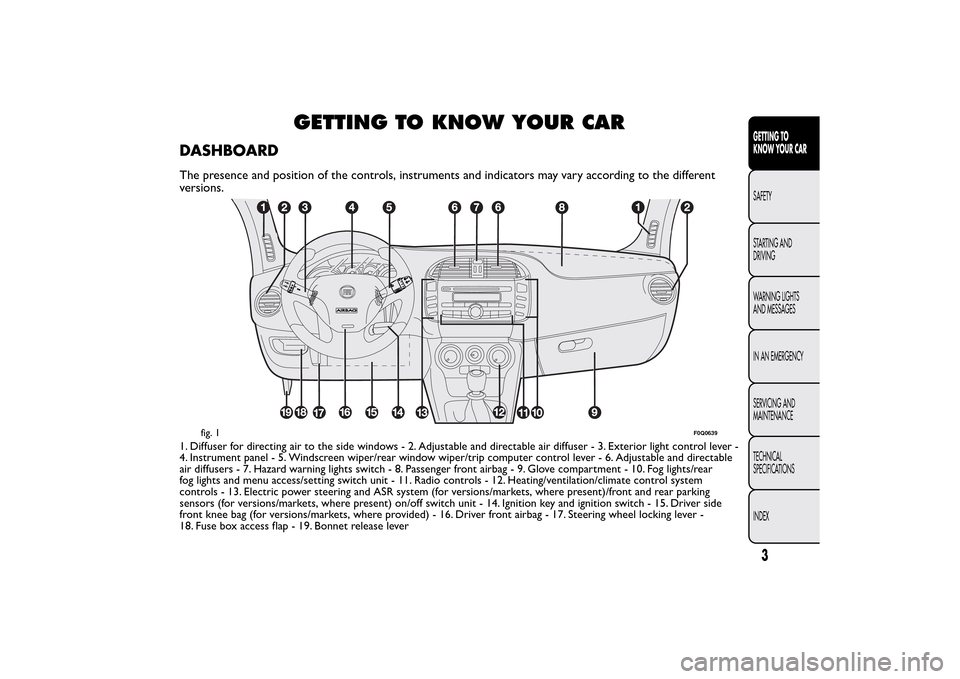
GETTING TO KNOW YOUR CAR
DASHBOARDThe presence and position of the controls, instruments and indicators may vary according to the different
versions.1. Diffuser for directing air to the side windows - 2. Adjustable and directable air diffuser - 3. Exterior light control lever -
4. Instrument panel - 5. Windscreen wiper/rear window wiper/trip computer control lever - 6. Adjustable and directable
air diffusers - 7. Hazard warning lights switch - 8. Passenger front airbag - 9. Glove compartment - 10. Fog lights/rear
fog lights and menu access/setting switch unit - 11. Radio controls - 12. Heating/ventilation/climate control system
controls - 13. Electric power steering and ASR system (for versions/markets, where present)/front and rear parking
sensors (for versions/markets, where present) on/off switch unit - 14. Ignition key and ignition switch - 15. Driver side
front knee bag (for versions/markets, where provided) - 16. Driver front airbag - 17. Steering wheel locking lever -
18. Fuse box access flap - 19. Bonnet release lever
fig. 1
F0Q0639
3GETTING TO
KNOW YOUR CARSAFETY
STARTING AND
DRIVING
WARNING LIGHTS
AND MESSAGES
IN AN EMERGENCY
SERVICING AND
MAINTENANCE
TECHNICAL
SPECIFICATIONS
INDEX
Page 23 of 275

IMPORTANT When one of the front doors is
opened, the display is activated, showing the time
and mileage for a few seconds.
SETUP MENU
The menu comprises a series of functions which can
be selected using the
and
buttons to access
the different selection and setting (setup) operations
indicated below.
Some options have a submenu.
The Setup Menu can be activated by pressing the
MODE button briefly.
If the Radionavigator is installed, only the following
functions can be adjusted/set from the instrument
panel: "Lighting", “Speed beep”, "Headlight sensor"
(for versions/markets, where provided), "Belt buzzer"
and "Passenger airbag". The other functions are
shown on the Radionavigator display. You can set and
adjust them there.
The menu comprises the following options:
❒LIGHTING
❒SPEED BEEP
❒HEADLIGHT SENSOR (for versions/markets,
where provided)
❒TRIP B ACTIVATION/DATA
❒SET TIME
❒SET DATE
❒FIRST PAGE (for versions/markets, where
provided)❒SEE RADIO
❒AUTOCLOSE
❒UNITS OF MEASUREMENT
❒LANGUAGE
❒WARNINGS VOLUME
❒BUTTON VOLUME
❒SEAT BELT BEEP/BUZZ.
❒SERVICE
❒AIRBAG/PASSENGER BAG
❒CORNERING LIGHTS (for versions/markets,
where provided)
❒EXIT MENU
Selecting an option from the main menu
without a submenu:
❒briefly press the MODE button to select the main
menu option that needs to be changed;
❒press buttons
or
(with single presses) to
select the new setting;
❒briefly press the MODE button to store the new
setting and at the same time go back to the
previously selected menu option.
19GETTING TO
KNOW YOUR CARSAFETY
STARTING AND
DRIVING
WARNING LIGHTS
AND MESSAGES
IN AN EMERGENCY
SERVICING AND
MAINTENANCE
TECHNICAL
SPECIFICATIONS
INDEX
Page 31 of 275
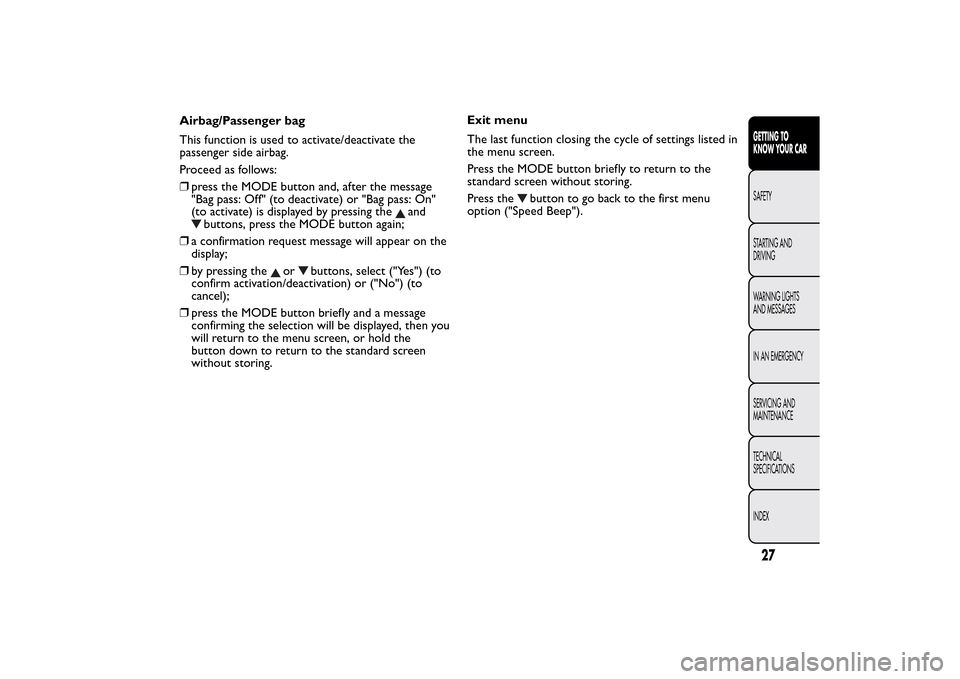
Airbag/Passenger bag
This function is used to activate/deactivate the
passenger side airbag.
Proceed as follows:
❒press the MODE button and, after the message
"Bag pass: Off" (to deactivate) or "Bag pass: On"
(to activate) is displayed by pressing the
and
buttons, press the MODE button again;
❒a confirmation request message will appear on the
display;
❒by pressing the
or
buttons, select ("Yes") (to
confirm activation/deactivation) or ("No") (to
cancel);
❒press the MODE button briefly and a message
confirming the selection will be displayed, then you
will return to the menu screen, or hold the
button down to return to the standard screen
without storing.Exit menu
The last function closing the cycle of settings listed in
the menu screen.
Press the MODE button briefly to return to the
standard screen without storing.
Press the
button to go back to the first menu
option ("Speed Beep").
27GETTING TO
KNOW YOUR CARSAFETY
STARTING AND
DRIVING
WARNING LIGHTS
AND MESSAGES
IN AN EMERGENCY
SERVICING AND
MAINTENANCE
TECHNICAL
SPECIFICATIONS
INDEX
Page 76 of 275

On some versions, a courtesy mirror with courtesy
light is fitted on the back of the visors. The light
allows the mirror to be used even in poor visibility
conditions.
Lift cover A to access the mirror.
If the ignition key is at STOP position, the light stays
on for about 15 minutes. If, during this period, a
door or the tailgate is opened, the 15 minute timing
is reset.
IMPORTANT On both sides of the sun visor there is
a label remembering that it is compulsory to
deactivate the airbags if a rearward facing child
restraint system is fitted. Always comply with the
instructions on the sun visor. (see the "Front airbags"
paragraph in chapter "Safety").
SUN ROOF(for versions/markets, where provided)
The large electric sun roof comprises two panes of
glass, one of which is mobile and the other fixed.
These are equipped with two
sun blinds (front and rear) that can be moved
manually.
The sun blinds be used in "fully closed" or "fully
open" positions (they have no fixed intermediate
positions).
To open the sun blinds: grip handle A fig. 65, release
it and move it in the direction of the arrows to
the "fully open" position.
To close them, carry out the procedure in reverse.
The sun roof can be operated only with the ignition
key turned to MAR-ON. The controls A and B fig. 66
on the trim next to the front roof light operate the
sun roof opening/closing functions.
fig. 65
F0Q0737
72GETTING TO
KNOW YOUR CAR
SAFETY
STARTING AND
DRIVING
WARNING LIGHTS
AND MESSAGES
IN AN EMERGENCY
SERVICING AND
MAINTENANCE
TECHNICAL
SPECIFICATIONS
INDEX
Page 121 of 275

When over 1.50 m in height, from the point of view
of restraint systems, children are considered as
adults and wear seat belts normally.
In Europe the characteristics of children restraint
systems are ruled by the regulation ECE-R44, dividing
them into five weight groups:Group Weight groups
Group 0 up to 10 kg of weight
Group 0+ up to 13 kg of weight
Group 1 9-18 kg in weight
Group 2 15-25 kg in weight
Group 3 22-36 kg of weightAll child restraint devices must bear the certification
data, together with the control mark, on a label
solidly fixed to the seat which must never be
removed.
Lineaccessori Fiat offers child restraint systems for
each weight group. These devices are recommended
having been specifically designed for Fiat cars.
WARNING
SEVERE DANGER.When an active
passenger airbag is fitted, DO NOT
install rear facing child restraint systems
on the front seat . Deployment of the
airbag in an accident could cause fatal injuries
to the child regardless of the severity of the
impact . It is advisable to always carr y children
in a child restraint system on the rear seat ,
which is the most protected position in the
event of a collision.
WARNING
On the sun visor there is a label with
suitable symbols reminding the user that
it is compulsory to deactivate the airbag if a
rear facing child restraint system is fitted.
Always comply with the instructions on the
passenger's side sun visor (see the "Front
airbag" paragraph).
WARNING
Do not move the front or rear seat if a
child is seated on it or on the dedicated
child restraint system.
117GETTING TO KNOW
YOUR CARSAFETYSTARTING AND
DRIVING
WARNING LIGHTS
AND MESSAGES
IN AN EMERGENCY
SERVICING AND
MAINTENANCE
TECHNICAL
SPECIFICATIONS
INDEX
Page 129 of 275
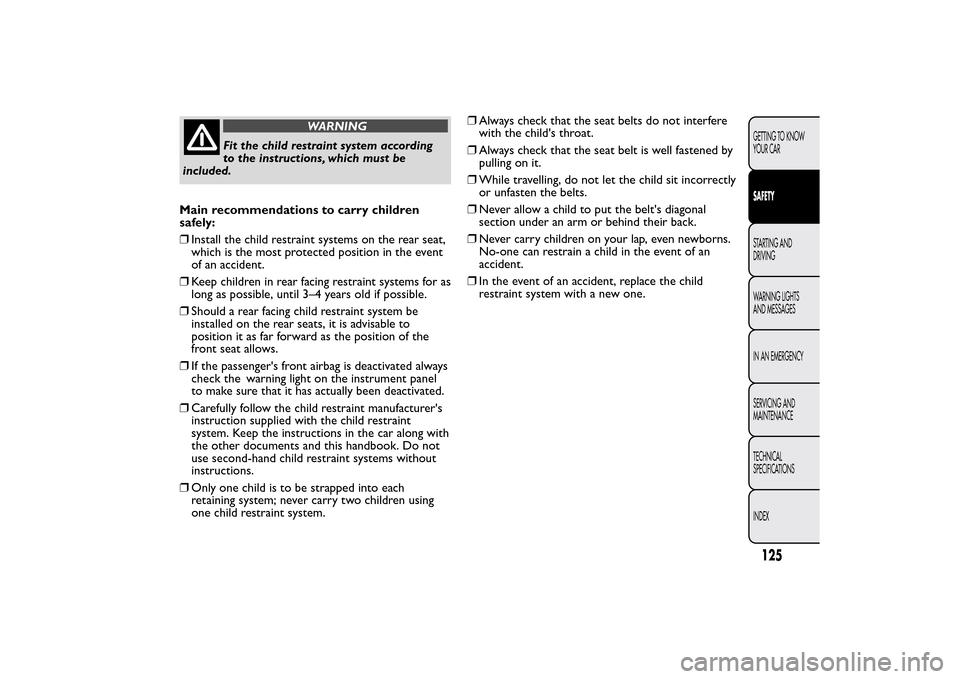
WARNING
Fit the child restraint system according
to the instructions, which must be
included.
Main recommendations to carry children
safely:
❒Install the child restraint systems on the rear seat,
which is the most protected position in the event
of an accident.
❒Keep children in rear facing restraint systems for as
long as possible, until 3–4 years old if possible.
❒Should a rear facing child restraint system be
installed on the rear seats, it is advisable to
position it as far forward as the position of the
front seat allows.
❒If the passenger's front airbag is deactivated always
check the warning light on the instrument panel
to make sure that it has actually been deactivated.
❒Carefully follow the child restraint manufacturer's
instruction supplied with the child restraint
system. Keep the instructions in the car along with
the other documents and this handbook. Do not
use second-hand child restraint systems without
instructions.
❒Only one child is to be strapped into each
retaining system; never carry two children using
one child restraint system.❒Always check that the seat belts do not interfere
with the child's throat.
❒Always check that the seat belt is well fastened by
pulling on it.
❒While travelling, do not let the child sit incorrectly
or unfasten the belts.
❒Never allow a child to put the belt's diagonal
section under an arm or behind their back.
❒Never carry children on your lap, even newborns.
No-one can restrain a child in the event of an
accident.
❒In the event of an accident, replace the child
restraint system with a new one.
125GETTING TO KNOW
YOUR CARSAFETYSTARTING AND
DRIVING
WARNING LIGHTS
AND MESSAGES
IN AN EMERGENCY
SERVICING AND
MAINTENANCE
TECHNICAL
SPECIFICATIONS
INDEX
Page 130 of 275
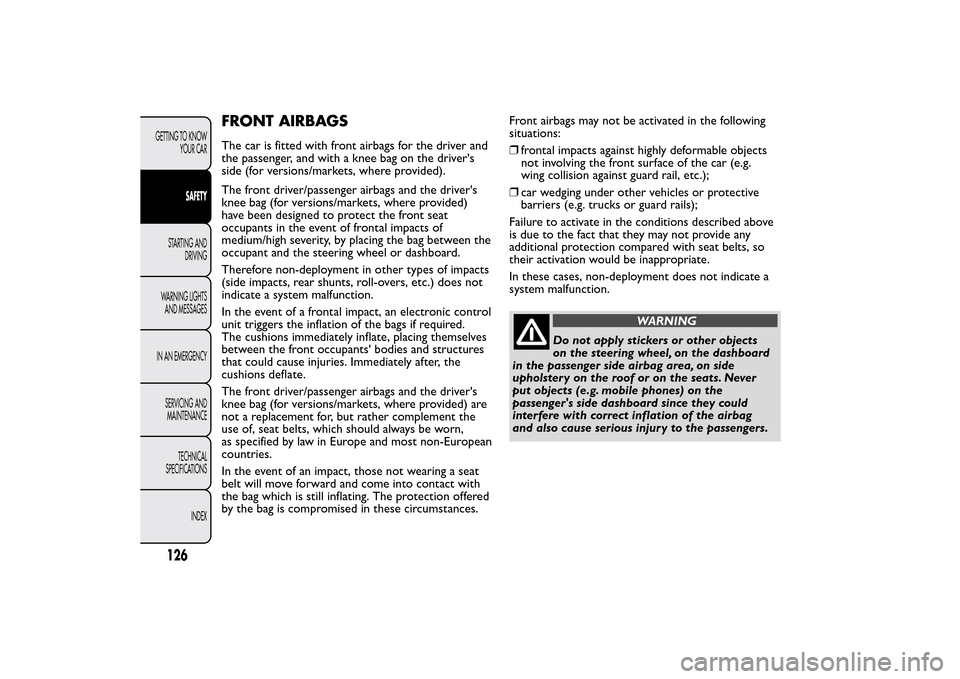
FRONT AIRBAGSThe car is fitted with front airbags for the driver and
the passenger, and with a knee bag on the driver's
side (for versions/markets, where provided).
The front driver/passenger airbags and the driver's
knee bag (for versions/markets, where provided)
have been designed to protect the front seat
occupants in the event of frontal impacts of
medium/high severity, by placing the bag between the
occupant and the steering wheel or dashboard.
Therefore non-deployment in other types of impacts
(side impacts, rear shunts, roll-overs, etc.) does not
indicate a system malfunction.
In the event of a frontal impact, an electronic control
unit triggers the inflation of the bags if required.
The cushions immediately inflate, placing themselves
between the front occupants' bodies and structures
that could cause injuries. Immediately after, the
cushions deflate.
The front driver/passenger airbags and the driver's
knee bag (for versions/markets, where provided) are
not a replacement for, but rather complement the
use of, seat belts, which should always be worn,
as specified by law in Europe and most non-European
countries.
In the event of an impact, those not wearing a seat
belt will move forward and come into contact with
the bag which is still inflating. The protection offered
by the bag is compromised in these circumstances.Front airbags may not be activated in the following
situations:
❒frontal impacts against highly deformable objects
not involving the front surface of the car (e.g.
wing collision against guard rail, etc.);
❒car wedging under other vehicles or protective
barriers (e.g. trucks or guard rails);
Failure to activate in the conditions described above
is due to the fact that they may not provide any
additional protection compared with seat belts, so
their activation would be inappropriate.
In these cases, non-deployment does not indicate a
system malfunction.
WARNING
Do not apply stickers or other objects
on the steering wheel, on the dashboard
in the passenger side airbag area, on side
upholstery on the roof or on the seats. Never
put objects (e.g. mobile phones) on the
passenger's side dashboard since they could
interfere with correct inflation of the airbag
and also cause serious injur y to the passengers.
126GETTING TO KNOW
YOUR CAR
SAFETY
STARTING AND
DRIVING
WARNING LIGHTS
AND MESSAGES
IN AN EMERGENCY
SERVICING AND
MAINTENANCE
TECHNICAL
SPECIFICATIONS
INDEX
Page 131 of 275
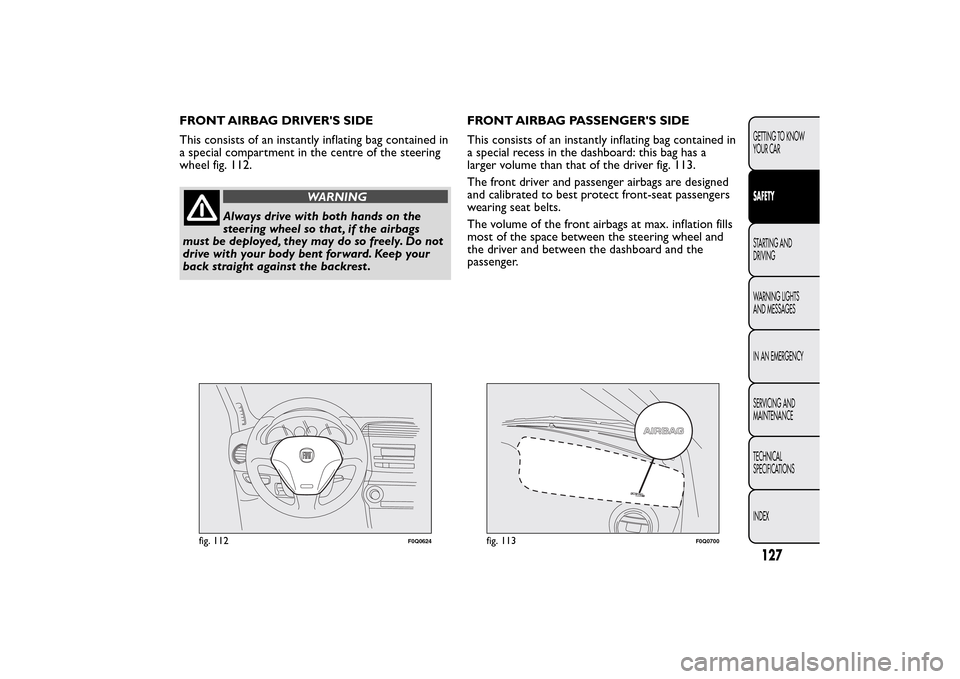
FRONT AIRBAG DRIVER'S SIDE
This consists of an instantly inflating bag contained in
a special compartment in the centre of the steering
wheel fig. 112.
WARNING
Always drive with both hands on the
steering wheel so that , if the airbags
must be deployed, they may do so freely. Do not
drive with your body bent forward. Keep your
back straight against the backrest .FRONT AIRBAG PASSENGER'S SIDE
This consists of an instantly inflating bag contained in
a special recess in the dashboard: this bag has a
larger volume than that of the driver fig. 113.
The front driver and passenger airbags are designed
and calibrated to best protect front-seat passengers
wearing seat belts.
The volume of the front airbags at max. inflation fills
most of the space between the steering wheel and
the driver and between the dashboard and the
passenger.
fig. 112
F0Q0624
fig. 113
F0Q0700
127GETTING TO KNOW
YOUR CARSAFETYSTARTING AND
DRIVING
WARNING LIGHTS
AND MESSAGES
IN AN EMERGENCY
SERVICING AND
MAINTENANCE
TECHNICAL
SPECIFICATIONS
INDEX